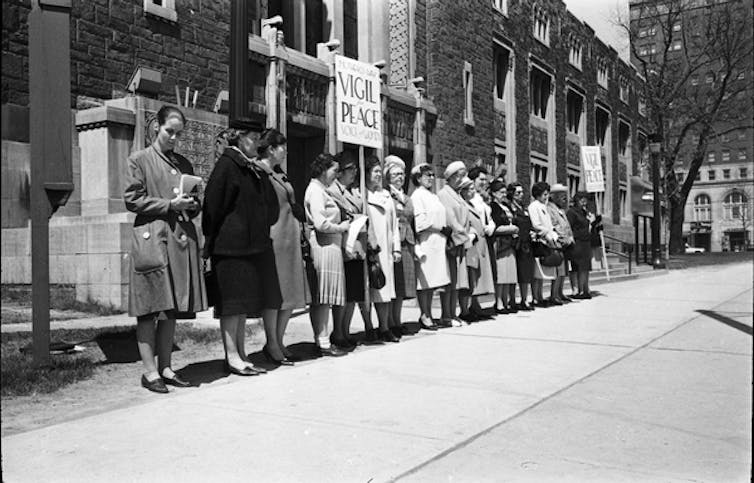 |
| Mother’s Day Vigil for Peace outside the Royal Ontario Museum in Toronto by Voice of Women a Canadian peace group, May 11, 1963. |
Today is Mothers’ Day –
a time we set aside to honor the women who have meant so much to us.
In the culture around us, Mothers’ Day has taken a turn from its original intention,
and for the past few years in this church we have tried to say that Mothers’ Day isn’t just about the woman who gave birth to us,
but it is about remembering and honoring all women of faith who have affected us in our personal lives and throughout history.
In the world around us today, Mothers’ Day is a pretty big deal.
Hallmark plans for 150 million greeting cards to be exchanged today.
More telephone calls are made today than any other day of the year.
An average of $150 will be spent on gifts today – did you get yours?
The Saturday before Mothers’ Day is the busiest day of the year at the car wash.
And the week before Mothers’ Day is the busiest sales time for Veronica’s Secret stores.
!!!!!?????!!!!!
It is good and right for us to take time to think about the woman in our lives who brought us up,
taught us values,
gave us life,
encouraged us along our way.
But, you know, there is something about Mothers’ Day that has gotten lost over the years.
Mother's Day originally was not the kind of day it has become.
It was not invented by Hallmark cards or the association of retail florists.
It was not originally conceived of as a day to give presents to Mother and bring her breakfast in bed. Not that there's anything wrong with those activities, but that was not the original purpose of Mother's Day.
Mothers' Day [note the difference in spelling] in North America goes back to at least 1858 when Anna Reeves Jarvis organised a Mothers' Day in West Virginia to urge the authorities to improve sanitation for the people who lived in the Appalachians.
Out of that initial effort came a group of women that provided medical services for soldiers and civilians on both sides of the Civil War.
Just after the war, Anna Jarvis organized a “Mother’s Friendship Day” in which mothers from both North and South whose sons had died in battle came, each dressed in blue or gray and held hands and sang together.
In 1870, poet/philanthropist Julia Ward Howe proposed that there be an annual Mothers' Day for Peace.
Remember after seeing the horrors of a battle, she wrote The Battle Hymn of the Republic – never intended as a fight song, by the way.
Julia Ward Howe was horrified at the slaughter caused by the battles of the Civil War, and at the slaughter that was taking place in the Franco-Prussian war in Europe.
And she called for the observance of a Mothers' Day.
It was her intent that women everywhere should show their opposition to military conflict.
She said, "Why do not the mothers of mankind interfere in these matters to prevent the waste of that human life of which they alone bear and know the cost."
The Mothers' Day movement that she organised continued to have an annual celebration in the Northeastern United States until the turn of the twentieth century.
In 1908, Anna Jarvis’s daughter, also named Anna Jarvis, organized a Mother’s Day at her church in West Virginia.
She wanted to recognize the unappreciated work that mothers do and to call for peace in the home and in the world.
Word of a good idea traveled fast.
The very next year, Mother’s Day was celebrated in 45 states!
In 1914 the Congress of the United States formally adopted an annual Mother's Day celebration, but not surprisingly they established it as a festival of home and family life rather than as a protest against the horror and senseless slaughter of military conflict.